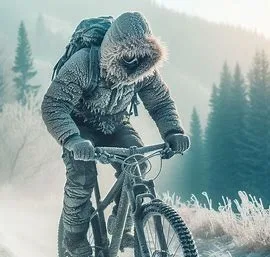Cold weather MTB gear might not be your first priority when you hit the trails. But we think consideration here is wise and a checklist would be useful. Lets face it, winter isn’t always the best time for any type of cycling but preferences differ. Some even prefer winter over summer, but the fact remains that you’ll usually want to prep differently when the mercury turns lower. One key difference vs. road cycling, mountain biking usually entails slower speeds and a more explosive use of energy. As such, mountain bikers generally warm up more quickly and require less layers. Still, there are a few things always useful to pack. And you always run the risk of a mechanical, so consider that you may be stationary for a while in the cold! Our philosophy is that you can usually make do with products you already own, rather than specific MTB or cycling marketed products.
Here are our recommendations for what to consider:
Head Protection
Head protection is priority one. Notwithstanding the debunked idea that heat loss is mostly from ones head (not strictly true), the ears in particular can be a problem on the trails. They are one of the first areas to feel extremely uncomfortable. To combat cold ears, you do not need any kind of MTB or even cycling specific product. Stick with a simple headband of skullcap. If you are cycling in temps significantly below freezing, go with a balaclava.
Glasses
Most cyclists know the pain of cold air blowing in ones eyes. The problem isn’t just the discomfort, but the constant sobbing your eyes will do in response to it! This is one of the products you should be wearing anyway however. Debris and dust can kick up into ones eyes even in the best weather. Nothing fancy is required here, but a pair of clear lenses protective glasses is all that is required. If the trail is a bit snowy then sunglasses are in order.
Base Layers
The main principle in keeping warm generally is layering of course. I’ve found that if the temperature is above freezing, it is super easy to overlayer. As such, be smart about what you wear. A long sleeved t-shirt might be appropriate for an above freezing day given the exertion of the sport. Below freezing, a base layer thermal top will be required. Wearing long johns on the bottom will usually only be required on the coldest of days. Remember that obviously you can shed layers, but you’ll really hate your day if you underlayer.
Mountain Biking Gloves
Another product we’d put in the category of “always required” is MTB gloves. Protecting your hands in the best weather, these will also serve you well in the cold. Unless you have circulation issues you likely won’t need more than this in subarctic temps. Hand warmers will likely be all you need in addition if so.
Padded Shorts
While we’re on the topic of standard gear, good idea to always use these. That goes for road and MTB cycling. You will not believe the pain signals your ass is capable of producing if you choose to forego them. There is some ancillary benefit for cold weather protection as well.
Wind Proof Cycling Jacket
At the end of the day if the weather is at freezing or below and the wind is blowing, pack a wind proof jacket. If it turns out its too much you can shed this layer after a short time. Some more windy situations above freezing might warrant this as well. An MTB tailored jacket is usually not necessary and just ends up being more expensive.
Footwear
A few manufacturers make specific mountain biking shoes, but these are expensive and often unnecessary in our opinion. To keep the feet warm on the coldest days, a pair of shoe covers is usually enough. Beyond that, knee high socks will keep both your legs and feet warm.
Onesies
The nuclear option of cold weather MTB gear; the onesie. Generally speaking these are more expensive than their worth, but useful if budget allows. They will only really be necessary below freezing and otherwise more of a fashion than anything else. We wouldn’t consider this required gear, but a nice to have if in the most extreme climates.


